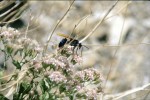
Click On Picture for Larger Image
Tarantula Hawk Wasps
Author: Ray Bowers
 Click On Picture for Larger Image |
Species: Pogonomyremex rugosus |
Description:
These large wasps have a velvety blue black body that is from 12 to
40mm (0.5 to 1.5in) long. The head has mouthparts modified into a tongue-like structure, large eyes, and
large antennae. The thorax has four red orange membranous wings, and long strong legs. There is a narrow
connection between the thorax and abdomen. The abdomen of the female has a sting, which evolved from an
egg laying organ.
Geographic range:
The tarantula hawk wasp is found across most of the Southwest down
into Mexico.
Habitat:
The tarantula hawk wasp is found in a variety of desert habitats such as
shrub lands, grasslands, and arroyos. They are often seen around flowers or running around on the
ground.
Food Web:
The adult feeds on nectar found in the flowers from a variety of desert
plants. The larva feed on a tarantula that the female has paralyzed and provided.
Reproduction and Development:
Mating occurs around flowers where the males and
females feed. The eggs are deposited on a paralyzed tarantula that the female has stung and placed in a
burrow. The grub-like larva feed on the tarantula. They next spin a golden colored cocoon around themselves
and go into a resting stage. They emerge from this resting stage as adults.
Behavior:
The tarantula hawk wasp is diurnal, but its prey is nocturnal; so most
hunting occurs at dusk. During the day they spend most of their time feeding around flowers. After mating
the female will search for a tarantula. This may involve finding a roaming male tarantula or a tarantula'sburrow. The female locates the tarantula burrows by using her sense of smell as she runs around on the
ground. When a burrow is found she will sometimes touch the silk around the burrow entrance to entice the
tarantula to come out of the burrow. The female must now sting the tarantula between the legs on the
underside of the spider. She may use the tarantula's burrow or drag the paralyzed tarantula to a burrow she
has made. She will next deposit eggs on the tarantula. The female may also use the venom in the sting as a
defensive weapon.
Ecosystem roles:
The adults feed on nectar and in the process help pollinate the
plants they visit. The female is one of the predators of tarantulas. Predators that can catch them also
prey upon the tarantula hawk wasps.
Taxonomy:
Kingdom: Animalia
Phylum: Arthropoda
Subphylum: Atelocerata
Class: Hexapoda
Order: Hymenoptera
Family: Pompillidae
Genus: Pepsis
Species: Pepsis chrysthemis
References:
Borror, Donald J. and Richard E. White. 1970. A Field Guide to the
Insects of America North of Mexico. Boston: Houghton Mifflin Co.
Borror, Donald J., Charles A. Triplehorn, and Norman F. Johnson. 1989. An Introduction to the Study of
Insects. Philadelphia: W. B. Saunders Co.
Bland, Roger G and H. E. Jaques.1978. How to Know Insects. Dubuque, Iowa: Wm. C. Brown Co.
Larson, Peggy and Lane Larson. 1977. The Deserts of the Southwest. San Francisco: Sierra Club Books.
MacMahon. James A.1985. Deserts. New York : Alfred A Knopf, Inc.
Werner, Floyd and Carl Olson. 1994. Insects of the Southwest. Fisher Books, LLC.
Related Terms: Hexapoda, Insects